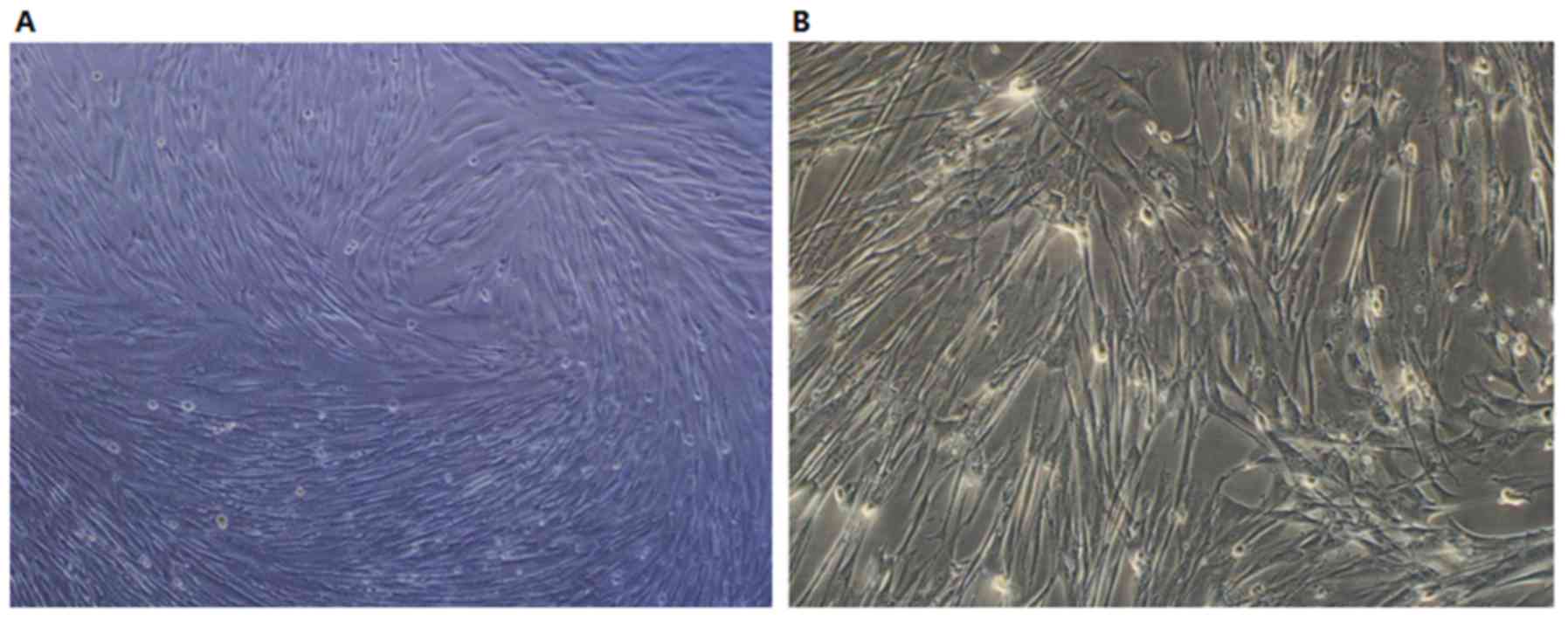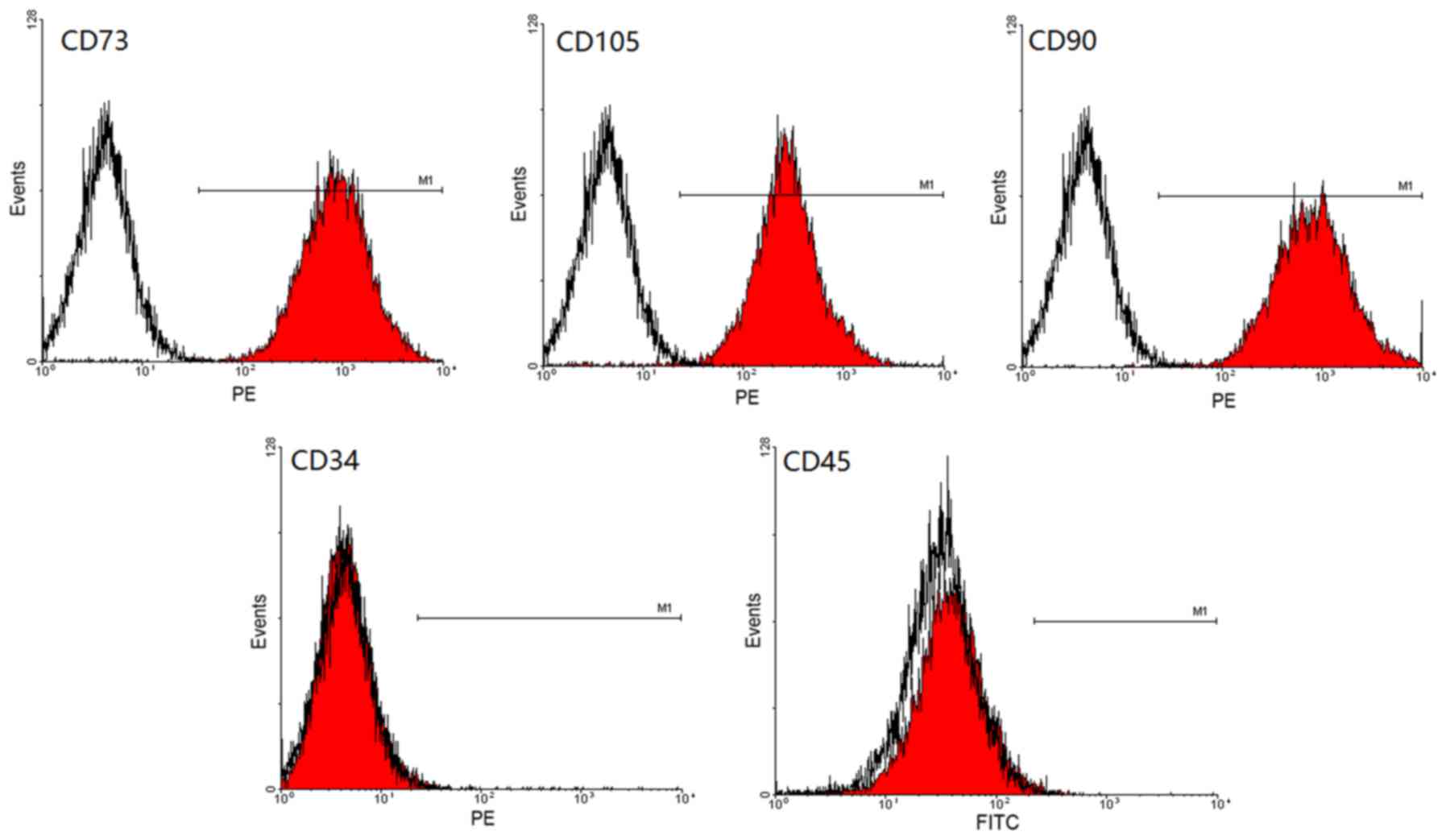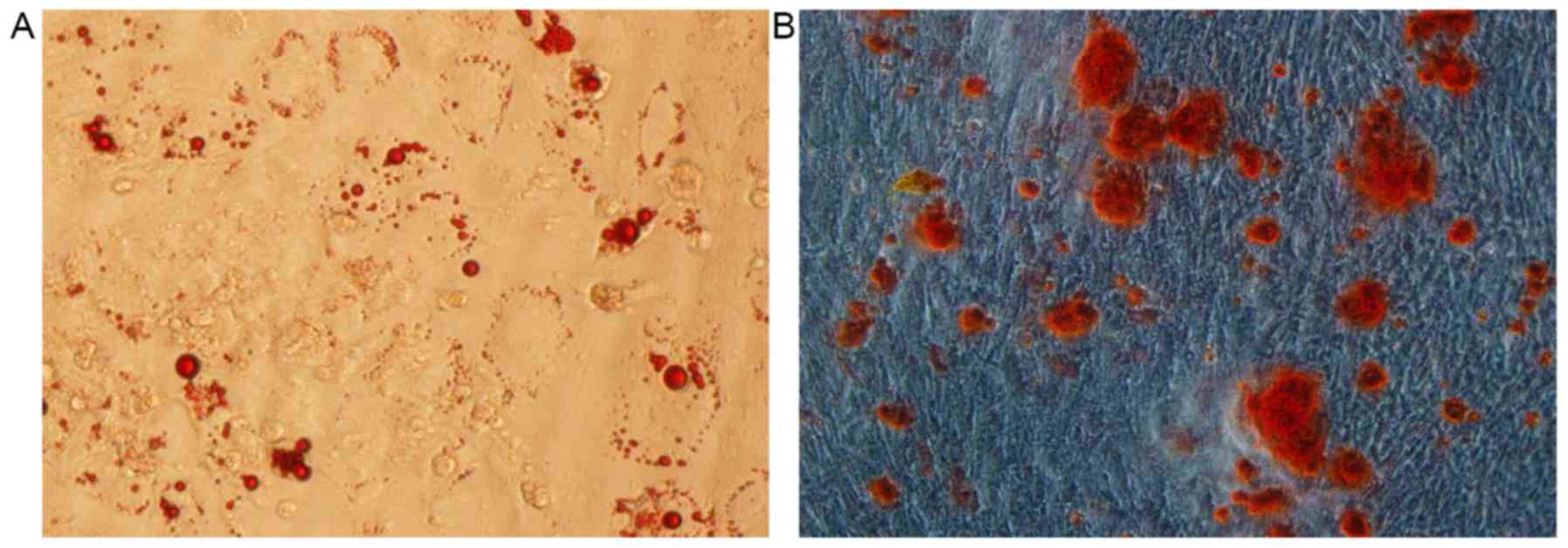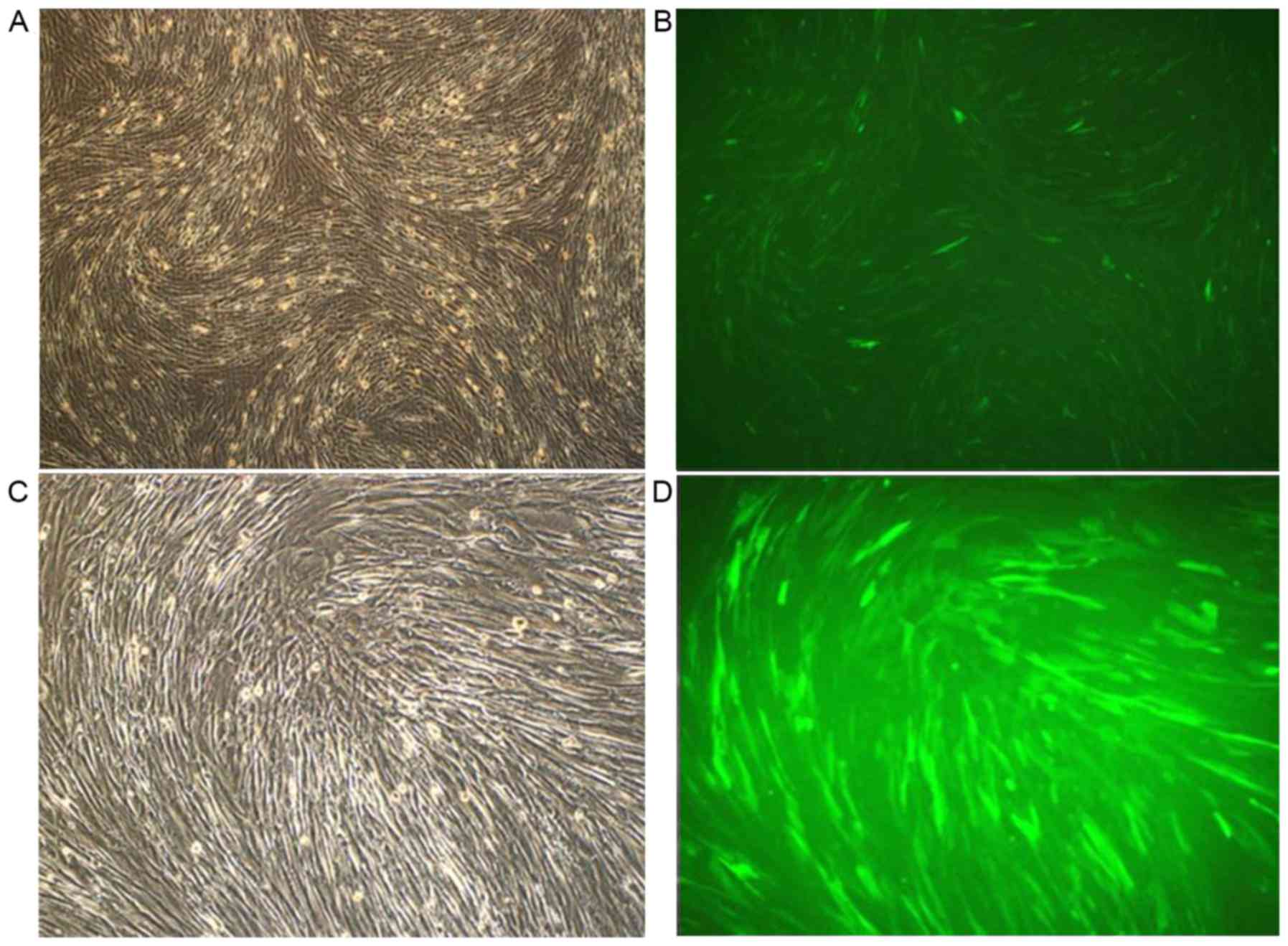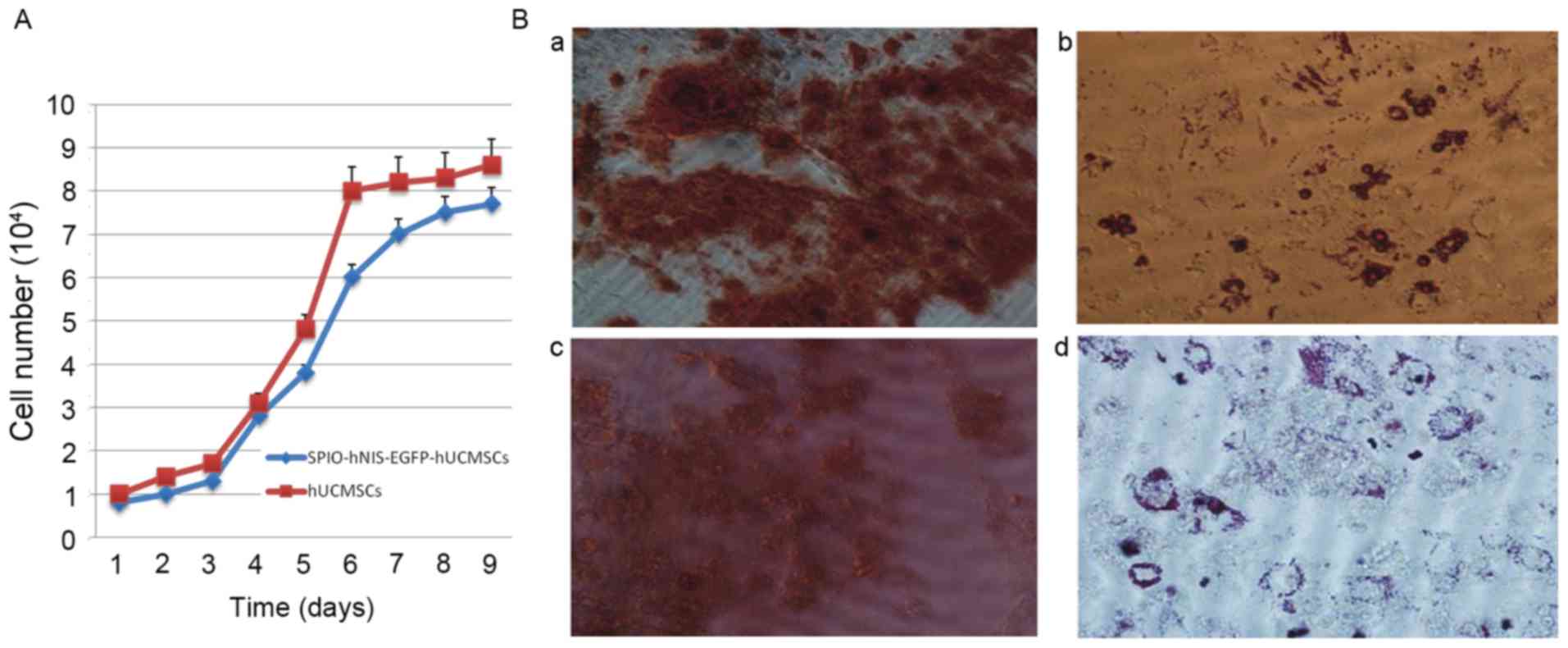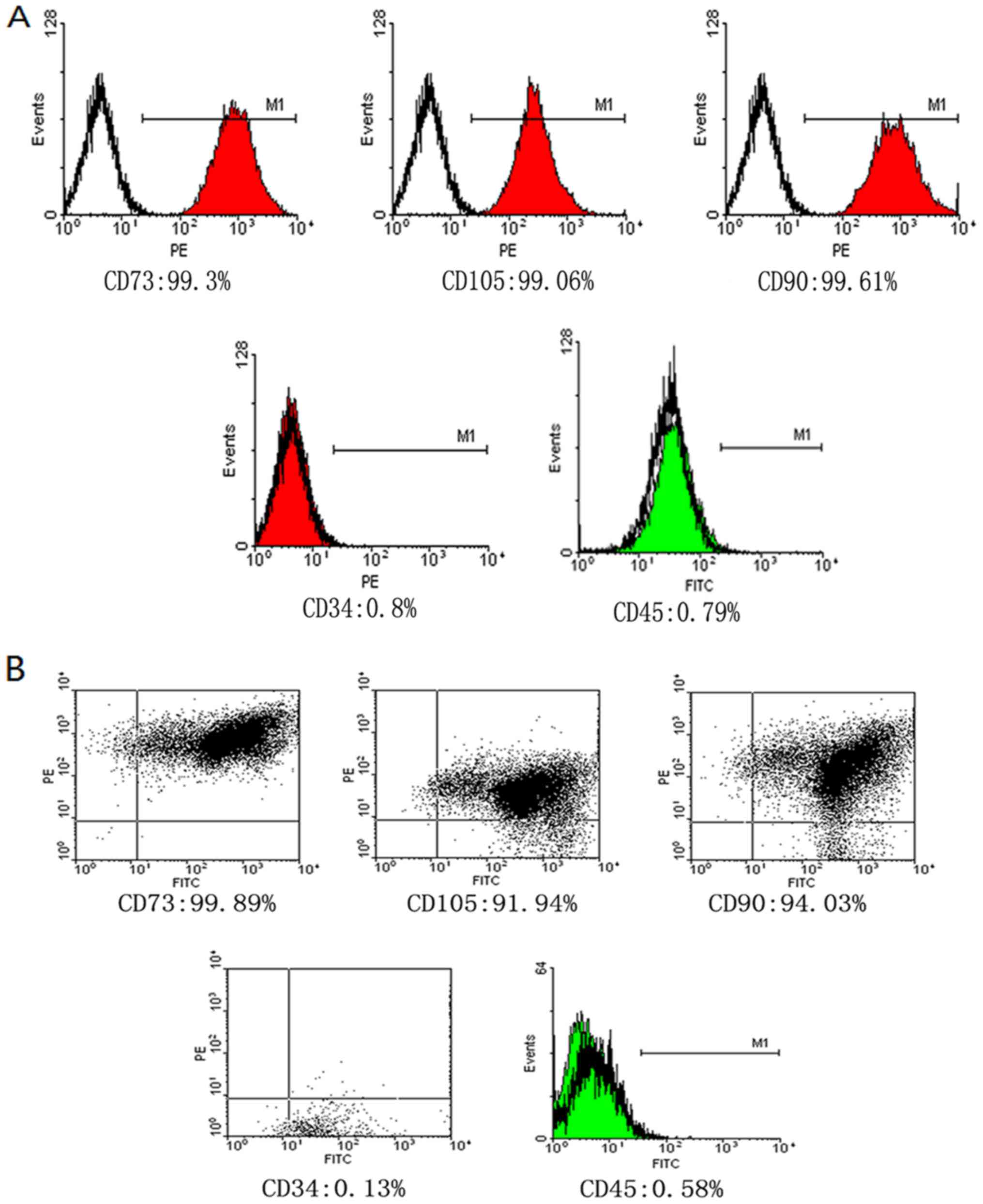|
1
|
Pittenger MF, Mackay AM, Beck SC, Jaiswal
RK, Douglas R, Mosca JD, Moorman MA, Simonetti DW, Craig S and
Marshak DR: Multilineage potential of adult human mesenchymal stem
cells. Science. 284:143–147. 1999. View Article : Google Scholar : PubMed/NCBI
|
|
2
|
Crisan M, Yap S, Casteilla L, Chen CW,
Corselli M, Park TS, Andriolo G, Sun B, Zheng B, Zhang L, et al: A
perivascular origin for mesenchymal stem cells in multiple human
organs. Cell Stem Cell. 3:301–313. 2008. View Article : Google Scholar : PubMed/NCBI
|
|
3
|
Tyndall A and Uccelli A: Multipotent
mesenchymal stromal cells for autoimmune diseases: Teaching new
dogs old tricks. Bone Marrow Transplant. 43:821–828. 2009.
View Article : Google Scholar : PubMed/NCBI
|
|
4
|
Huang H, Zhang X, Hu X, Shao Z, Zhu J, Dai
L, Man Z, Yuan L, Chen H, Zhou C and Ao Y: A functional biphasic
biomaterial homing mesenchymal stem cells for in vivo cartilage
regeneration. Biomaterials. 35:9608–9619. 2014. View Article : Google Scholar : PubMed/NCBI
|
|
5
|
Zhao C, Tian M and Zhang H: In vivo stem
cell imaging. Open Nucl Med J. 2:171–177. 2010. View Article : Google Scholar
|
|
6
|
Ezzat T, Dhar DK, Malago M and Damink Olde
SW: Dynamic tracking of stem cells in an acute liver failure model.
World J Gastroenterol. 18:507–516. 2012. View Article : Google Scholar : PubMed/NCBI
|
|
7
|
Xia T, Jiang H, Li C, Tian M and Zhang H:
Molecular imaging in tracking tumor stem-like cells. J Biomed
Biotechnol. 2012:4203642012. View Article : Google Scholar : PubMed/NCBI
|
|
8
|
Schwarz M, Dörfler A, Engelhorn T,
Struffert T, Tietze T, Janko C, Tripal P, Cicha I, Dürr S, Alexiou
C and Lyer S: Imaging modalities using magnetic
nanoparticles-overview of the developments in recent years.
Nanotechnology Reviews. 2013:142013.
|
|
9
|
Wolfs E, Holvoet B, Gijsbers R, Casteels
C, Roberts SJ, Struys T, Maris M, Ibrahimi A, Debyser Z, Van Laere
K, et al: Optimization of multimodal imaging of mesenchymal stem
cells using the human sodium iodide symporter for PET and Cerenkov
luminescence imaging. PLoS One. 9:e948332014. View Article : Google Scholar : PubMed/NCBI
|
|
10
|
Shearer RF and Saunders DN: Experimental
design for stable genetic manipulation in mammalian cell lines:
Lentivirus and alternatives. Genes Cells. 20:1–10. 2015. View Article : Google Scholar : PubMed/NCBI
|
|
11
|
Pavlovic M, Koehler N, Anton M,
Dinkelmeier A, Haase M, Stellberger T, Busch U and Baiker AE:
Reverse transcription quantitative polymerase chain reaction for
detection of and differentiation between RNA and DNA of HIV-1-based
lentiviral vectors. Hum Gene Ther Methods. 28:215–221. 2017.
View Article : Google Scholar : PubMed/NCBI
|
|
12
|
Kantor B, McCown T, Leone P and Gray SJ:
Clinical applications involving CNS gene transfer. Adv Genet.
87:71–124. 2014.PubMed/NCBI
|
|
13
|
Hu YL, Fu YH, Tabata Y and Gao JQ:
Mesenchymal stem cells: A promising targeted-delivery vehicle in
cancer gene therapy. J Control Release. 147:154–162. 2010.
View Article : Google Scholar : PubMed/NCBI
|
|
14
|
Gao Z, Zhang L, Hu J and Sun Y:
Mesenchymal stem cells: A potential targeted-delivery vehicle for
anti-cancer drug, loaded nanoparticles. Nanomedicine. 9:174–184.
2013. View Article : Google Scholar : PubMed/NCBI
|
|
15
|
Salehinejad P, Alitheen NB,
Nematollahi-Mahani SN, Ali AM, Omar AR, Janzamin E and Hajghani M:
Effect of culture media on expansion properties of human umbilical
cord matrix-derived mesenchymal cells. Cytotherapy. 14:948–953.
2012. View Article : Google Scholar : PubMed/NCBI
|
|
16
|
Dwyer RM, Ryan J, Havelin RJ, Morris JC,
Miller BW, Liu Z, Flavin R, O'Flatharta C, Foley MJ, Barrett HH, et
al: Mesenchymal stem cell-mediated delivery of the sodium iodide
symporter supports radionuclide imaging and treatment of breast
cancer. Stem Cells. 29:1149–1157. 2011. View Article : Google Scholar : PubMed/NCBI
|
|
17
|
Zhong X, Shi C, Gong J, Guo B, Li M and Xu
H: Experimental study of nasopharyngeal carcinoma radionuclide
imaging and therapy using transferred human sodium/iodide symporter
gene. PLoS One. 10:e01170532015. View Article : Google Scholar : PubMed/NCBI
|
|
18
|
Visser FW, Muntinga JH, Dierckx RA and
Navis G: Feasibility and impact of the measurement of extracellular
fluid volume simultaneous with GFR by 125I-iothalamate. Clin J Am
Soc Nephrol. 3:1308–1315. 2008. View Article : Google Scholar : PubMed/NCBI
|
|
19
|
Riekstina U, Cakstina I, Parfejevs V,
Hoogduijn M, Jankovskis G, Muiznieks I, Muceniece R and Ancans J:
Embryonic stem cell marker expression pattern in human mesenchymal
stem cells derived from bone marrow, adipose tissue, heart and
dermis. Stem Cell Rev. 5:378–386. 2009. View Article : Google Scholar : PubMed/NCBI
|
|
20
|
Nan C, Shi Y, Zhao Z, Ma S, Liu J, Yan D,
Song G and Liu H: Monosialoteterahexosyl ganglioside induces the
differentiation of human umbilical cord-derived mesenchymal stem
cells into neuron-like cells. Int J Mol Med. 36:1057–1062. 2015.
View Article : Google Scholar : PubMed/NCBI
|
|
21
|
Ding DC, Chang YH, Shyu WC and Lin SZ:
Human umbilical cord mesenchymal stem cells: A new era for stem
cell therapy. Cell Transplant. 24:339–347. 2015. View Article : Google Scholar : PubMed/NCBI
|
|
22
|
Yang C, Lei D, Ouyang W, Ren J, Li H, Hu J
and Huang S: Conditioned media from human adipose tissue-derived
mesenchymal stem cells and umbilical cord-derived mesenchymal stem
cells efficiently induced the apoptosis and differentiation in
human glioma cell lines in vitro. Biomed Res Int. 2014:1093892014.
View Article : Google Scholar : PubMed/NCBI
|
|
23
|
Dayem M, Basquin C, Navarro V, Carrier P,
Marsault R, Chang P, Huc S, Darrouzet E, Lindenthal S and Pourcher
T: Comparison of expressed human and mouse sodium/iodide symporters
reveals differences in transport properties and subcellular
localization. J Endocrinol. 197:95–109. 2008. View Article : Google Scholar : PubMed/NCBI
|
|
24
|
Zhou QB, Chen RF, Li ZH, Pan QH, Zhou JJ,
Tang QB and Chen JS: Human mucin 1 promoter drives human
sodium/iodide symporter gene targeting expression in pancreatic
carcinoma cells. Zhonghua Yi Xue Za Zhi. 87:2780–2784. 2007.(In
Chinese). PubMed/NCBI
|
|
25
|
Han H, He W, Wang W and Gao B: Inhibitory
effect of aqueous Dandelion extract on HIV-1 replication and
reverse transcriptase activity. BMC Complement Altern Med.
11:1122011. View Article : Google Scholar : PubMed/NCBI
|
|
26
|
Che J, Doubrovin M, Serganova I, Ageyeva
L, Beresten T, Finn R and Blasberg R: HSP70-inducible
hNIS-IRES-eGFP reporter imaging: Response to heat shock. Mol
Imaging. 6:404–416. 2007. View Article : Google Scholar : PubMed/NCBI
|
|
27
|
Merron A, Peerlinck I, Martin-Duque P,
Burnet J, Quintanilla M, Mather S, Hingorani M, Harrington K, Iggo
R and Vassaux G: SPECT//CT imaging of oncolytic adenovirus
propagation in tumours in vivo using the Na//I symporter as a
reporter gene. Gene Ther. 14:1731–1738. 2007. View Article : Google Scholar : PubMed/NCBI
|
|
28
|
Spitzweg C, Baker CH, Bergert ER, O'Connor
MK and Morris JC: Image-guided radioiodide therapy of medullary
thyroid cancer after carcinoembryonic antigen promoter-targeted
sodium iodide symporter gene expression. Hum Gene Ther. 18:916–924.
2007. View Article : Google Scholar : PubMed/NCBI
|
|
29
|
Eekels JJ, Pasternak AO, Schut AM, Geerts
D, Jeeninga RE and Berkhout B: A competitive cell growth assay for
the detection of subtle effects of gene transduction on cell
proliferation. Gene Ther. 19:1058–1064. 2012. View Article : Google Scholar : PubMed/NCBI
|
|
30
|
Serrano-Nascimento C, da Silva Teixeira S,
Nicola JP, Nachbar RT, Masini-Repiso AM and Nunes MT: The acute
inhibitory effect of iodide excess on sodium/iodide symporter
expression and activity involves the PI3K/Akt signaling pathway.
Endocrinology. 155:1145–1156. 2014. View Article : Google Scholar : PubMed/NCBI
|
|
31
|
Siddiqui F, Barton KN, Stricker HJ, Steyn
PF, Larue SM, Karvelis KC, Sparks RB, Kim JH, Brown SL and Freytag
SO: Design considerations for incorporating sodium iodide symporter
reporter gene imaging into prostate cancer gene therapy trials. Hum
Gene Ther. 18:312–322. 2007. View Article : Google Scholar : PubMed/NCBI
|
|
32
|
Bitsika V, Roubelakis MG, Zagoura D,
Trohatou O, Makridakis M, Pappa KI, Marini FC, Vlahou A and Anagnou
NP: Human amniotic fluid-derived mesenchymal stem cells as
therapeutic vehicles: A novel approach for the treatment of bladder
cancer. Stem Cells Dev. 21:1097–1111. 2012. View Article : Google Scholar : PubMed/NCBI
|
|
33
|
Nedeau AE, Gallagher KA, Liu ZJ and
Velazquez OC: Elevation of hemopexin-like fragment of matrix
metalloproteinase-2 tissue levels inhibits ischemic wound healing
and angiogenesis. J Vasc Surg. 54:1430–1438. 2011. View Article : Google Scholar : PubMed/NCBI
|
|
34
|
Zhu Y, Cheng M, Lu N, Luo S, Xie Y and Liu
D: Construction of NK4 gene lentiviral vector and its expression in
bone mesenchymal stem cells. Sheng Wu Yi Xue Gong Cheng Xue Za Zhi.
28:976–981. 2011.(In Chinese). PubMed/NCBI
|
|
35
|
Notka F and Wagner R: Reprogramming a GFP
reporter gene subjects it to complex lentiviral gene regulation.
Methods Mol Biol. 813:85–106. 2012. View Article : Google Scholar : PubMed/NCBI
|
|
36
|
Nethercott HE, Brick DJ and Schwartz PH:
Derivation of induced pluripotent stem cells by lentiviral
transduction. Methods Mol Biol. 767:67–85. 2011. View Article : Google Scholar : PubMed/NCBI
|
|
37
|
Buzon MJ, Erkizia I, Pou C, Minuesa G,
Puertas MC, Esteve A, Castello A, Santos JR, Prado JG,
Izquierdo-Useros N, et al: A non-infectious cell-based phenotypic
assay for the assessment of HIV-1 susceptibility to protease
inhibitors. J Antimicrob Chemother. 67:32–38. 2012. View Article : Google Scholar : PubMed/NCBI
|
|
38
|
Kim JE, Ahn BC, Hwang MH, Jeon YH, Jeong
SY, Lee SW and Lee J: Combined RNA interference of hexokinase II
and (131)I-sodium iodide symporter gene therapy for anaplastic
thyroid carcinoma. J Nucl Med. 52:1756–1763. 2011. View Article : Google Scholar : PubMed/NCBI
|
|
39
|
Timmons CL, Shao Q, Wang C, Liu L, Liu H,
Dong X and Liu B: GB virus type C E2 protein inhibits human
immunodeficiency virus type 1 assembly through interference with
HIV-1 gag plasma membrane targeting. J Infect Dis. 207:1171–1180.
2013. View Article : Google Scholar : PubMed/NCBI
|
|
40
|
Chen L, Altmann A, Mier W, Eskerski H,
Leotta K, Guo L, Zhu R and Haberkorn U: Radioiodine therapy of
hepatoma using targeted transfer of the human sodium/iodide
symporter gene. J Nucl Med. 47:854–862. 2006.PubMed/NCBI
|
|
41
|
Saraswathy A, Nazeer SS, Nimi N, Arumugam
S, Shenoy SJ and Jayasree RS: Synthesis and characterization of
dextran stabilized superparamagnetic iron oxide nanoparticles for
in vivo MR imaging of liver fibrosis. Carbohydr Polym. 101:760–768.
2014. View Article : Google Scholar : PubMed/NCBI
|
|
42
|
Ittrich H, Peldschus K, Raabe N, Kaul M
and Adam G: Superparamagnetic iron oxide nanoparticles in
biomedicine: Applications and developments in diagnostics and
therapy. Rofo. 185:1149–1166. 2013. View Article : Google Scholar : PubMed/NCBI
|
|
43
|
Hansen L, Hansen AB, Mathiasen AB, Ng M,
Bhakoo K, Ekblond A, Kastrup J and Friis T: Ultrastructural
characterization of mesenchymal stromal cells labeled with
ultrasmall superparamagnetic iron-oxide nanoparticles for clinical
tracking studies. Scand J Clin Lab Invest. 74:437–446. 2014.
View Article : Google Scholar : PubMed/NCBI
|
|
44
|
Chao Y, Karmali PP and Simberg D: Role of
carbohydrate receptors in the macrophage uptake of dextran-coated
iron oxide nanoparticles. Adv Exp Med Biol. 733:115–123. 2012.
View Article : Google Scholar : PubMed/NCBI
|
|
45
|
van Buul GM, Kotek G, Wielopolski PA,
Farrell E, Bos PK, Weinans H, Grohnert AU, Jahr H, Verhaar JA,
Krestin GP, et al: Clinically translatable cell tracking and
quantification by MRI in cartilage repair using superparamagnetic
iron oxides. PLoS One. 6:e170012011. View Article : Google Scholar : PubMed/NCBI
|
|
46
|
Levin MC, Lidberg U, Jirholt P, Adiels M,
Wramstedt A, Gustafsson K, Greaves DR, Li S, Fazio S, Linton MF, et
al: Evaluation of macrophage-specific promoters using lentiviral
delivery in mice. Gene Ther. 19:1041–1047. 2012. View Article : Google Scholar : PubMed/NCBI
|
|
47
|
Sykova E and Jendelova P: In vivo tracking
of stem cells in brain and spinal cord injury. Prog Brain Res.
161:367–383. 2007. View Article : Google Scholar : PubMed/NCBI
|















